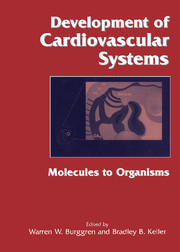Book contents
- Frontmatter
- Contents
- List of contributors
- Foreword by Constance Weinstein
- Introduction: Why study cardiovascular development?
- Part I Molecular, cellular, and integrative mechanisms determining cardiovascular development
- Part II Species diversity in cardiovascular development
- Part III Environment and disease in cardiovascular development
- Epilogue: Future directions in developmental cardiovascular sciences
- References
- Systematic index
- Subject index
Introduction: Why study cardiovascular development?
Published online by Cambridge University Press: 10 May 2010
- Frontmatter
- Contents
- List of contributors
- Foreword by Constance Weinstein
- Introduction: Why study cardiovascular development?
- Part I Molecular, cellular, and integrative mechanisms determining cardiovascular development
- Part II Species diversity in cardiovascular development
- Part III Environment and disease in cardiovascular development
- Epilogue: Future directions in developmental cardiovascular sciences
- References
- Systematic index
- Subject index
Summary
Socrates, Aristotle, Vesalius, and Galileo are just a few of the long list of notables who have written of their fascination with the rhythmic pulsing of the red spot evident in an opened bird egg. Our curiosity has not abated during the long history of human interest in cardiovascular development. Today we are still fascinated observers of that red spot as we attempt to identify the scientific underpinnings of cardiovascular development and correlate these findings with disease states in humans. Fortunately, our tools have expanded far beyond those of the ancient observers to include phase-contrast microscopy, pulsed Doppler flow, gene sequencing, genetic manipulation, high-performance liquid chromatography, and gel electrophoresis, to name but a few of the techniques the reader will encounter in this book. We are also beginning to appreciate the power of a comparative approach that employs a variety of animal species with different, yet similar, cardiovascular characteristics. Where have these observations of ever increasing sophistication led us?
The primacy of the developing cardiovascular system
We know that the cardiovascular system is the first system to begin functioning in a developing animal. So many of the contributors to this book began their first drafts with these words that, as editors, we felt that we must instead highlight this point once, prominently, at the beginning of the book. The developing heart and circulation do deserve particularly close scrutiny because of their fundamental role in the developmental process.
- Type
- Chapter
- Information
- Development of Cardiovascular SystemsMolecules to Organisms, pp. 1 - 4Publisher: Cambridge University PressPrint publication year: 1998



